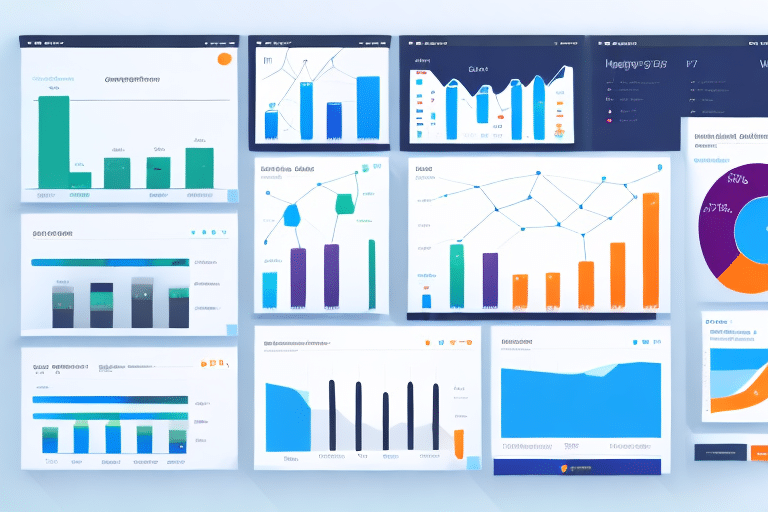Comparing Critical E-Commerce Operations Metrics: Site Traffic vs Page Views
As online shopping continues to grow, e-commerce businesses need to focus on measuring and improving their performance to gain a competitive edge. In this pursuit, they often rely on metrics like site traffic and page views to make informed decisions and drive growth. However, it's crucial to understand the differences between these two metrics and how they impact e-commerce operations.
Understanding the Importance of E-Commerce Metrics
E-commerce metrics are essential for businesses to understand how their online stores are performing. These metrics help e-commerce businesses track their success, identify areas for improvement, and make data-driven decisions. They also assist in optimizing strategies, increasing conversions, and boosting sales.
Key E-Commerce Metrics to Monitor
- Conversion Rate: Measures the percentage of website visitors who make a purchase. According to Shopify, the average e-commerce conversion rate is around 2.86%.
- Average Order Value (AOV): Indicates the average amount spent by customers per order. Increasing AOV can significantly impact overall revenue.
- Customer Acquisition Cost (CAC): Calculates the cost of acquiring a new customer. Keeping CAC low ensures that marketing efforts are cost-effective.
- Customer Lifetime Value (CLV): Measures the total value a customer brings to a business over their lifetime. A higher CLV suggests strong customer loyalty and retention.
By tracking these metrics, businesses can optimize their strategies, enhance customer experiences, and drive sustainable growth.
Defining Site Traffic and Page Views
Understanding the distinction between site traffic and page views is fundamental for effective e-commerce strategy.
Site Traffic
Site traffic refers to the number of individuals who visit your website over a specific period. It's an essential metric for gauging the overall popularity and reach of your online store.
- Unique Visitors: Represents individual users visiting the site.
- Sessions: The number of visits to the site, including repeat visits by the same user.
Page Views
Page views indicate the total number of pages viewed on your website by all visitors. This metric provides insight into how much content visitors consume during their visits.
- Per Visit Page Views: Average number of pages viewed during a single session.
- Popular Pages: Identifies which pages attract the most attention from visitors.
In summary, while site traffic measures the number of visitors, page views assess the level of engagement and interaction with your website's content.
Comparing Site Traffic and Page Views
The primary difference between site traffic and page views lies in what they measure. Site traffic provides an estimate of the number of unique visitors to your site, whereas page views track how many pages each visitor views, including multiple views by the same user.
Site Traffic: Audience Size
Site traffic offers an estimate of your website's audience size. Higher traffic generally increases the potential for conversions, as more visitors mean more opportunities for sales.
Page Views: Engagement Level
Page views are a more accurate measure of how engaged visitors are with your content. A high number of page views per visit can indicate that users find your content valuable and are exploring multiple products or information areas.
Influencing Factors
Site traffic can be influenced by various factors such as search engine optimization (SEO), social media marketing, and advertising campaigns. These efforts can drive more visitors to your site but may not always result in increased engagement or page views.
Conversely, page views are directly related to the quality and relevance of your website’s content. Well-structured content encourages visitors to explore more pages, enhancing engagement.
Impact of Site Traffic on E-Commerce Operations
Site traffic plays a pivotal role in e-commerce operations by determining the potential customer base and the effectiveness of marketing strategies.
Expanding Customer Reach
Higher site traffic means reaching a larger audience, increasing the chances of attracting potential customers. According to Statista, e-commerce sales worldwide are expected to reach $6.54 trillion by 2023, highlighting the vast potential of online traffic.
Marketing Effectiveness
Analyzing site traffic sources helps businesses determine which marketing channels are most effective. For instance, if a significant portion of traffic comes from social media, investing more in social media advertising could yield better returns.
Revenue Potential
Increased traffic directly correlates with higher revenue potential. However, it's essential to ensure that the traffic is qualified—meaning visitors are likely to convert into paying customers.
Enhancing E-Commerce Performance through Page Views
Page views are integral to understanding user behavior and optimizing the website for better performance.
Content Optimization
Analyzing page views helps identify which content resonates most with visitors. High page views on product pages can indicate popular items, while low views might suggest the need for better promotion or redesign.
User Experience Improvement
Understanding how visitors navigate through your site allows you to enhance the user experience. For example, if visitors frequently exit from a particular page, it may require optimization to retain their interest.
Inventory Management
Page view analytics can inform inventory decisions. Products with high page views but low sales may need additional marketing or adjustments in pricing strategies.
Factors Influencing Site Traffic and Page Views
Several factors contribute to the levels of site traffic and page views in an e-commerce setting.
Search Engine Optimization (SEO)
Effective SEO practices improve your website’s visibility on search engines, driving more organic traffic. According to Moz, implementing on-page SEO strategies can increase organic traffic by up to 55%.
Content Quality
High-quality, relevant content attracts and retains visitors, encouraging them to explore more pages. Engaging blog posts, detailed product descriptions, and informative articles can significantly boost page views.
Website Design and Usability
A well-designed website with intuitive navigation enhances user experience, making it easier for visitors to find and view multiple pages. Responsive design ensures accessibility across all devices, further increasing engagement.
Marketing Campaigns
Targeted marketing campaigns, including email marketing, pay-per-click (PPC) advertising, and social media promotions, drive both site traffic and page views by attracting and engaging users.
Measuring and Analyzing E-Commerce Metrics
Accurate measurement and thorough analysis of site traffic and page views are crucial for making informed business decisions.
Utilizing Web Analytics Tools
Tools like Google Analytics provide comprehensive data on site traffic and page views. They offer insights into user behavior, traffic sources, and conversion rates.
Best Practices for Measurement
- Set Clear Goals: Define what you aim to achieve with your website, such as increasing traffic, enhancing engagement, or boosting sales.
- Monitor Key Metrics: Focus on metrics that align with your business objectives, such as unique visitors, bounce rate, and time on site.
- Analyze Trends: Regularly review data to identify patterns and trends that can inform strategic decisions.
- Benchmark Performance: Compare your metrics against industry standards to assess your website’s performance.
Balancing Site Traffic and Page Views for Optimal Success
Achieving the right balance between site traffic and page views is essential for e-commerce success. Focusing solely on one metric can lead to skewed strategies that may not contribute to overall business goals.
Integrated Strategy Development
Develop strategies that simultaneously aim to increase site traffic and enhance page views. For instance, SEO efforts can drive more visitors, while high-quality content can encourage them to explore more pages.
Setting Balanced Goals
Establish goals that consider both the quantity and quality of traffic. For example, aim to increase unique visitors by 20% while also enhancing the average page views per session by 15%.
Continuous Optimization
Regularly optimize both metrics by testing different approaches. A/B testing can help determine which changes lead to better engagement and higher traffic.
Strategies to Optimize Metrics Effectively
Implementing targeted strategies can effectively enhance both site traffic and page views.
Leverage SEO Best Practices
- Conduct keyword research to target relevant search terms.
- Optimize meta tags, headers, and content for better search engine ranking.
- Build high-quality backlinks to increase domain authority.
Create Engaging Content
- Develop informative blog posts, how-to guides, and product tutorials.
- Incorporate multimedia elements like images, videos, and infographics.
- Update content regularly to keep it fresh and relevant.
Enhance User Experience
- Ensure mobile responsiveness and fast loading times.
- Simplify navigation with clear menus and search functionality.
- Implement a clean and intuitive design to make browsing enjoyable.
Utilize Data-Driven Marketing
- Segment your audience to deliver personalized marketing messages.
- Use retargeting campaigns to re-engage visitors who have shown interest.
- Analyze campaign performance to refine strategies for better results.
Conclusion: Balancing Metrics for E-Commerce Success
Both site traffic and page views are essential metrics for e-commerce businesses. Neither metric is inherently more important than the other; instead, they complement each other in measuring and improving website performance. The key to e-commerce success lies in finding the right balance between increasing site traffic and enhancing user engagement through page views. By setting clear goals, utilizing data-driven analytics, and continuously optimizing strategies, businesses can drive growth, increase conversions, and achieve long-term sustainability.






















